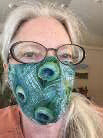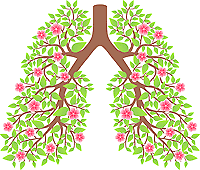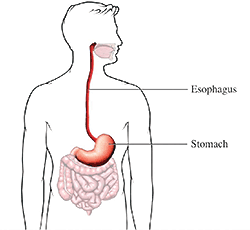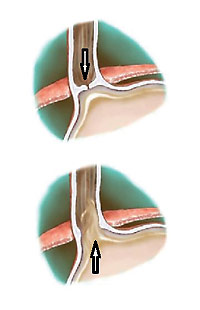|
|
HEALTHY HAPPENINGS December 2020
|
Boosting Immunity and Respiratory Strength
from the Oriental Medicine Perspective
by Debra Cahill, DOM, Lac |
 My intent with this article is to approach this topic from a perspective different than the Western medical approach. I wish to give preventative tips and tricks that you can put to use for yourself and your family. A brief summary of the Traditional Chinese Medicine (TCM) concept of “immunity” is that due to constitutional (roughly equivalent to genetic tendency), lifestyle, dietary and/or environmentally induced weaknesses in the individual there will be more or less tendency to respiratory illnesses such as asthma, chronic bronchitis, rhinitis, sinusitis, and chronic illnesses such as COPD, emphysema, and lung sarcoidosis. My intent with this article is to approach this topic from a perspective different than the Western medical approach. I wish to give preventative tips and tricks that you can put to use for yourself and your family. A brief summary of the Traditional Chinese Medicine (TCM) concept of “immunity” is that due to constitutional (roughly equivalent to genetic tendency), lifestyle, dietary and/or environmentally induced weaknesses in the individual there will be more or less tendency to respiratory illnesses such as asthma, chronic bronchitis, rhinitis, sinusitis, and chronic illnesses such as COPD, emphysema, and lung sarcoidosis.
This may also include a tendency to more colds, flu, bacterial and viral infections. We can improve upon our wellness, and what Western medicine calls our “immunity,” by taking this seasonal opportunity to boost the strength of the Lung and Kidney meridians. The Lung and Kidney meridians are influenced by seasonal changes, Fall and Winter respectively. Those with deficiencies in these meridians may suffer more of the illnesses listed above. Those that have strong Lung and Kidney meridian qi may also benefit from utilizing some of the following suggestions:
The first suggestion may seem old fashioned and it is. Our grandparents knew that covering our heads, chest, and upper body to protect ourselves from cold was a very effective way to prevent cold and flu susceptibility. This is consistent with an Oriental medicine concept of how pathogens are transmitted into the body. Also protect yourself from drafts, wind, and fans blowing on your upper body. Lastly, wearing a mask is a newer development in this regimen and wearing a mask protects others as well.
There is a long history in Oriental medicine of utilizing many plant-based medicines, including the use of essential oils which are the distilled essence of plants. I suggest a blend called Breathe (Doterra), which includes; laurel leaf, peppermint, eucalyptus, melaleuca, lemon, cardamom, ravintsara, and ravensara for opening breathing passages. A blend called On Guard (Doterra) includes; wild orange peel, clove bud, cinnamon bark, eucalyptus leaf, rosemary leaf is the blend that I use in my office to kill bacteria and virus in the air, including MRSA and SARS related viruses such as COVID-19. These essential oils may be combined or used individually in a diffuser, diluted with distilled water in a hand-held spray bottle, or applied diluted to the bottom of the feet on a point called Kidney 1. Kidney 1 is in the center of the foot in the “deep well,” below the ball. Applying medicinal oils to this point can help control coughing and wheezing, and even benefit sleep.
Finally, there are some foods which benefit the Lung and Kidney meridians. For example, walnuts, pears, goji berries, pear juice infused with cardamon, and pineapple, are only a few of the beneficial and delicious foods you can choose.
There is so much more detail I could give you, but not in this article. Please feel free to call me for a consultation and treatment, which would be customized to fit your needs. Be well.
(970) 242-0200
deb@healthrisingwellness.com
www.healthrisingwellness.com
Debra Cahill, DOM, Lac, is a Doctor of Oriental Medicine and licensed acupuncturist, in Utah, Colorado and New Mexico. She has been studying and practicing Oriental medicine for 16 years.
|
A Little Background on the Moab Company Glo Germ
Joe Kingsley, CEO Glo Germ Company. |
Back in 1968, Dean Luxton developed the basic Glo Germ products for his wife, who was Dean of Nursing at UCLA. After he moved to Castleton in Castle Valley, the company became a low priority for him. Then in 1978, Joe Kingsley became interested in the concept and purchased the Company and formulas, resulting in the company activities moving from Los Angeles, CA to Castle Valley, UT! This required the marketing to start all over again from scratch.
The bottles were filled using Poplar Place beer pitchers after mixing the formula by hand, using the outdoor picnic table as the platform to fill the bottles. Just me, my wife, and kids! And usually, just on weekends in Castle Valley at the Homestead!
What a trip this has become. In the beginning, the annual sales were $600 per year for a good year. Now, the Glo Germ Company is worldwide, with approximately 50% of the sales international and annual sales climbing every year! Glo Germ now has four full-time team members and two part-time employees.
So, what is Glo Germ? Simply put, Glo Germ is a series of products we have developed over fifty years that accurately simulate the physical characteristics of bacteria. In the ’80s, the graduate students at Georgetown University spent a semester studying the accuracy of the handwashing tools of Glo Germ and found that the oil and powder were 98% accurate and the gel was at 89%! Originally, Glo Germ was used for handwashing training and cross-contamination demonstrations.
With the insight and help of our team, several more products have been developed locally. Most notably is the MIST, which accurately simulates a sneeze! Then we have the mini kit which is used by families for the home use or school science fairs to teach and demonstrate proper handwashing. Also, during the anthrax investigation, Glo Germ was used extensively by the FBI and a whole chapter of the book reporting on the subject is devoted to how they used Glo Germ in the research.
One of the most important applications are ones which we, at Glo Germ do not even know anything about! What does this mean?
Around the world, scientists use glo germ (notice the lower case to describe what has now become a noun!) in their various areas of their research. And trust me, the list is huge. And another application is the calibration of the cytometry instruments used in doing DNA testing. Virtually all of these instruments around the world use Glo Germ from Moab for calibrating the system!
Want to get more information? Please visit our website at www.glogerm.com and see the videos and meet most of the team members! And by the way, the “germ” below is Buster, our mascot! And thank you for your interest in the international Moab company celebrating 52 years of fighting the bad bacteria by exposing how they travel in our world!
|
What is Your Heartburn Telling You?
by Ray Andrew, MD |
 Heartburn has become so common that a handful of drug companies make billions of dollars a year by suppressing it one day at a time with acid-blocking pills. For some, heartburn is no more than an uncomfortable nuisance, prompting them to keep a bottle of Tums close at hand. For others, it’s a terrifying experience waking up in the night with severe chest pain. Heartburn has become so common that a handful of drug companies make billions of dollars a year by suppressing it one day at a time with acid-blocking pills. For some, heartburn is no more than an uncomfortable nuisance, prompting them to keep a bottle of Tums close at hand. For others, it’s a terrifying experience waking up in the night with severe chest pain.
Whatever the experience, our instinctive response is to look for a pill that takes away the pain so we can get on with our day—or night—and hopefully forget about it. Naturally, discovering that antacids and acid-blocking drugs make the pain go away convinces us that our problem is too much acid production in the stomach. But the television commercials never prompt us to ask ourselves (nor our doctors) why we might be producing too much acid, or even to confirm that we are. Confirmation is accomplished using a 24-hour pH probe in the stomach. But this is rarely done anymore. Instead, we are led to conclude that if an acid-blocking drug makes the pain go away, this is proof-positive that excess acid is the culprit.
While this line of reasoning makes sense, it is inaccurate. Heartburn can be caused by too much acid, but this is usually not the case. The stomach was designed to make acid for a number of reasons. For example, acid is required for protein digestion. Proteins themselves are too large to be absorbed into the bloodstream. They have to be broken down into amino acids, which can then be absorbed. Cells throughout the body then use amino acids to make enzymes, muscles, bones, joints, many of our neurotransmitters, and much more.
 Stomach acid is also essential for adequate absorption of Vitamins D and B12, magnesium, calcium, zinc, iron, chromium, manganese, copper and other vitamins and minerals. Over time, deficiencies of these nutrients contribute to depression, osteoporosis, cancer, autoimmune disease, anxiety, insomnia, yeast overgrowth, hair loss, charley horses, food allergies, rashes (including hives), diarrhea, constipation, weak fingernails, acne, asthma, bloating, belching, gas, gallbladder problems, etc. Stomach acid is also essential for adequate absorption of Vitamins D and B12, magnesium, calcium, zinc, iron, chromium, manganese, copper and other vitamins and minerals. Over time, deficiencies of these nutrients contribute to depression, osteoporosis, cancer, autoimmune disease, anxiety, insomnia, yeast overgrowth, hair loss, charley horses, food allergies, rashes (including hives), diarrhea, constipation, weak fingernails, acne, asthma, bloating, belching, gas, gallbladder problems, etc.
Further, low stomach acid allows infecting organisms (that would normally be killed by the acid) to get past the stomach and set up infections in other areas. This can lead to either food poisoning or imbalance between the healthy and unhealthy bacteria in the gut.
By design, therefore, the stomach should have a pH between 1 and 3, which is very acidic. By contrast, the esophagus naturally has a pH around 7, which is neutral. Whenever acid makes its way from the stomach into the esophagus, you may experience a very uncomfortable burning sensation (some people develop a chronic cough instead). This sensation does not mean you have too much acid. Rather, it means you have acid in a part of the body that was not designed for it.
So, your next question should be: "How did acid get from a place where it belongs to a place where it does not belong?" The answer lies in the chemistry and physiology of a segment of muscle that separates the stomach from the esophagus.
The esophageal sphincter opens when you swallow so food can move into your stomach. The rest of the time, this muscle remains tight enough to prevent food and stomach acid from going the wrong way. Well, that’s the way it’s supposed to work. But a variety of triggers cause this muscle to relax when it’s not supposed to, allowing acid to enter and burn the esophagus.
One very common trigger that may surprise you is low stomach acid. If the pH of the stomach is too high from not having enough acid, the esophageal sphincter relaxes. How does this happen? Eating too fast prevents the stomach from making enough acid in time. Age is another common culprit: More than half of people over age 60 have low stomach acid. By age 85, this number climbs to 80%. A third common trigger of low acid is a microorganism called Helicobacter Pylori. This bacterium is better known for its ability to cause ulcers. What you may not realize is that it causes far more heartburn than it does ulcers. Additional causes of low stomach acid include thyroid deficiency, suboptimal adrenal function, and prolonged stress.
Other conditions lead to inappropriate opening of the esophageal sphincter. Obesity, as well as pregnancy, increases pressure on the stomach, which increases pressure on the sphincter muscle. Unhealthy bacteria in the intestines, yeast overgrowth, food sensitivities, nicotine, alcohol, caffeine, bile deficiency, digestive enzyme deficiency, too much exercise, magnesium deficiency, low-chloride diet, parasites, hiatal hernia, and some medications also cause heartburn.
Finally, there are foods that can further relax an already-weakened sphincter: high-fat foods, mint, spicy foods, citrus juices, chocolate, salt and salty foods, onions, carbonated beverages, and milk.
Like many other health conditions, heartburn often results from a combination of factors rather than a single trigger. Identifying and fixing the underlying causes not only prevents you from having to take a dangerous acid-blocking pill for the rest of your life. It will likely eliminate other symptoms you are having, and reduce your risks of many diseases down the road as well.
If you are tired of trying to cover up your symptoms; if you can’t seem to find that magic pill that will make you all better; or if you find the idea of taking an acid-blocking drug for the rest of your life unsatisfactory, call Prestige Wellness Institute for a new approach.
|
|
In Uncertain Times it's Better to be Prepared
by Alicia Wright |
ESSENTIAL SUPPLIES:
Flashlights, batteries, candles, kerosene lamp/fuel, matches
Propane/Gas: Min 1 extra tank/5 gallons
Food Storage—Min 1-week supply per person (Dried/canned food). MREs, extra pet food. Water Storage—1 gallon per person per day. (At least 1-week supply)
Medical Supplies—Prescriptions meds, over-the-counter meds, bandages+ (Coban/2x2 gauze), small kit. Communication—2-Way Radio, Satellite phone
Cleaning Supplies—Bleach, alcohol, vinegar, garbage bags, TP?
Personal Hygiene—Tampons, diapers, contacts/case/solution, toothbrush/paste+ Entertainment—Games, puzzles, books for kids/adults, art supplies.
Personal protection—Have what you need to feel safe.
BUG OUT BAG: Backpack ready to mobilize, sleeping supplies, water (3 liters), matches/fire starter, 3-day supply of dried food, small stove, water filter/straw, change of clothes, extra socks.
What is our level of PREPAREDNESS if the power grid goes down?
No Electricity, No Cell Phone, No Computer, No Wi-Fi, No Water, No Heat, No Commerce.
1. Remain CALM!
2. BREATHE (deeply and slowly through the nose)
3. Light a candle/find flashlight
4. Put on a warm layer
5. Make a fire/light heater
6. Make a meal/drink water
7. Assess next move toward communication network (connect with neighbors/community beforehand to make a plan)
8. Hunker down in place if necessary
How do we become INDEPENDENT from the power grid in Moab,UT?
Alternative power sources: Solar/wind/generator
Alternative heat sources: Wood/propane/diesel
Alternative water supply: Matrimony Springs
Alternative travel: Mill Creek Bike Path
Alternative communication—Gather to share/exchange goods: Full moon—Dusk @ Moab Plaza+
Alternative meeting locations: Rotary Park /Swanny Park /Lions Park
Alternative network for basic needs: Contribution Collective list of resources+ |
|
|
|
|
|
|
© 2002-2024 Moab Happenings. All rights
reserved.
Reproduction of information contained in this site is
expressly prohibited.
|
|